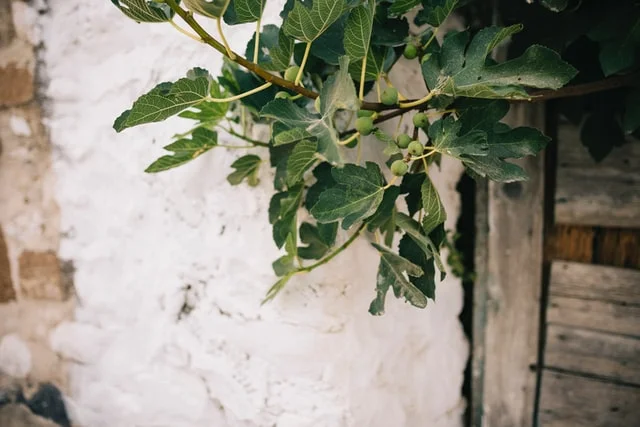Table of Contents
Introduction
The fig, Ficus Carica, is a deciduous tree that has its flowers within its green/brown or purple fruit. The fig plant prefers a warm dry climate and a sheltered position.
The fig tree will live for many years, and with some care, it will continue to bear fruit. The common fig does very well in the home garden, it is an ancient tree, and easy to propagate.
How to Care for a Fig Plant
The fig plant likes to be warm, so try to grow it in full sun and supply it with a high nitrogen fertilizer, this should be applied every 4 weeks over spring and summer.
Water your fig plant moderately, especially when it is setting fruit. The fig will not tolerate frosts very well, so if you have one in a pot, you will need to bring it inside in winter.
Alternatively, in a cold climate position the fig plant against a stone or brick wall to allow it to be sheltered and warm. The edible fig will need about 100 hours of cooler weather to fruit. Figs send out suckers and they should be trimmed off annually.
What Does Your Fig Plant Require?
The roots of the fig plant are close to the surface, once your tree is established you will need to mulch it regularly and water well during Summer. Eight hours of sun per day is required by most fruit trees.
The fig plant is not attacked by many pests, as it is fairly hardy. Many figs require a wasp, to pollinate the flowers through the small white eye at the end of the fruit, so don’t chase the wasps away as they are essential to your crop.
Remember figs flower on the inside, and in many cases, this is how it happens, weird but true. This is another reason not to use chemicals on your fig plant.
- Light requirements are full sun and a sheltered position.
- Temperature requirements, figs are subtropical and require a Mediterranean climate, hot summers, cool winters.
- Soil requirements, for fig plant in a raised bed or mound of prepared, rich soil, plenty of organic matter, and mulch, home-made compost.
- Humidity requirements, fig plant will grow in some humidity, but they don’t like wet feet, that is why planting in a mound is suggested.
- How to water, when setting fruit water well daily, and your fig can fruit twice a year with a heavier crop in later summer.
- How to fertilize, fig plant requires a neutral PH, so select your fertilizer accordingly, and mulching is very important.
More Fig Information Pests, Pruning and Propagation
The fig plant is fairly hardy, and not a lot of diseases affect the tree, but there are a few things to watch out for.
Pests affecting Your Fig Plant
If you live on the coast, your fig plant may be affected by fig rust or Anthracnose. This is a fungal disease-producing powdery yellow spots.
Copper-based fungicides are used for this problem that is easily treated. Leaves turn yellow and fall off when rust is present.
Fruit Fly is a common pest in many areas, where the flies lay their eggs in ripening fruit causing it to rot. Fallen fruit should be picked up and disposed of to prevent further infection.
Simple pheromone traps are set to destroy male fruit flies, check the traps regularly.
Fig mosaic virus causes a mottling of the leaves, plants with this virus should be destroyed.
Pruning Your Fig Plant
The first fig crop of the season forms on last years wood, the fruit will usually form in the leaf axils, look at the new wood, and you will see it developing.
So pruning is not done very often and is fairly straightforward. Any dead branches or diseased wood should be removed.
A more mature fig plant may need heavier pruning to encourage new growth. Leave some old wood on your tree. as this is where your first crop of the season will come from.
Propagating Fig Plant
Fig plants are easy to propagate from a cutting, take a dormant hardwood cutting by taking 12″ pieces from the end of branches. This should be done in July in the Northern Hemisphere when everything is growing fast.
Plant the cuttings together in a pot containing a good potting mix, allowing the soil to cover the lower 4-6″. Keep the cuttings warm and water initially, and then don’t water for a few days, as we don’t want the roots to become waterlogged.
Warmth and humidity are factors in the success of your cutting, that is why you must do this in Summer or the cutting will not grow roots.
Because the hardwood cuttings are dormant, don’t worry too much about the quality of the light at the moment, as we are just focusing initially on getting root growth.
Rooting will take 3-4 weeks, and in some cases a bit longer when the roots are one to two inches and longer the cutting will be ready to be moved to its own pot to establish.
If you are going to plant the cutting directly into your garden ( not recommended), place a 2-liter water bottle with the bottom cut off over the cutting to shelter the cutting, and keep it warm.
When you see new growth appearing, you can remove this makeshift greenhouse.
Harvesting Your Fig Plant Crop
Once your figs appear ripe, they will be soft to the touch and smell sweet. Once you have removed them from the fig plant they will not continue to ripen, so it is important to be sure that they are ready.
When you remove them from the tree, put them carefully into your basket, as you don’t want to bruise them. When they are ripe, they are easily removed from the fig plant and you don’t have to tug them.
Conclusion
There are many ways to successfully grow fig plants and if your climate is a bit cool, try espaliering them along a stone wall.
Do this by erecting a stainless steel cable along the warmer side of the wall and plant your figs to climb along the length of it. This way you will be more likely to have a successful crop.
Photo by Marita Mones on Unsplash



